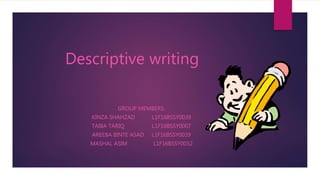descriptive writing
- 1. Descriptive writing GROUP MEMBERS: KINZA SHAHZAD L1F16BSSY0039 TAIBA TARIQ L1F16BSSY0007 AREEBA BINTE ASAD L1F16BSSY0039 MASHAL ASIM L1F16BSSY0032
- 2. WHAT YOU NEED TO KNOW ABOUT DECRIPTIVE WRITING..
- 3. What is description? ïĩ Description is giving details about a person, place, thing, etc that allows the reader to experience what you have observed. ïĩ In order to create a good description yu must appeal to the five senses and create pictures in the readerâs mind.
- 4. Look! ïĩ The first thing you have to do is observe your environment. ïĩ This includes the place, the people, the actions and the objects that are around you. ïĩ Remember although you are writing, imagine that you are telling your friend what you have experienced. Give them all the details they need.
- 5. Create word pictures ïĩ You already use adjectives in your writing but you should be even more creative. ïĩ You want to create pictures in thier minds. (word pictures or imagery). ïĩ Imagery does not only include what you see it also includes what you hear, smell, taste, touch and even feel.
- 6. Your reader must be able to close their eyes, listen to your words and create a mental image of what you are describing.
- 7. Some descriptive details to consider when describing an object ïĩ Examine: âĒ Colours âĒ Shapes âĒ Sizes âĒ Textures (how it feels)
- 8. Some descriptive details to consider while describing a person: ïĩ Examine: âĒ Physical appearance âĒ Facial expressions âĒ Attire âĒ Gestures (body movements)
- 9. What should you consider when describing a place ïĩ Examine the location. Is it a âĒ Natural world (trees, mountains, beaches) âĒ Man-made world (buildings, objects, vehicles) âĒ Imaginary world (aliens, unicorns)
- 10. Show not tell ïĩ One of the most important things to remember when youâre creating a description is to show not tell.
- 11. Show not tell SCENARIO 1 ïĩ One of the most important things to remember when you are creating a description is to show not tell.
- 12. Scenario 1 A. She was excited when her parents gave her permission to go to the party. B. Her eyes widened with surprise and her lips parted as she screamed with delight when her parents said, âYes.â
- 13. Show not tell SCENARIO 2 ïĩ You are in the midst of a thunderstorm. How would you describe this?
- 14. Scenario 2 A. The rain was falling heavily and everyone was afraid. B. The raindrops attacked the galvanized roof and the windows rattled. We huddled under the bed and hugged each other tightly.
- 15. Which one is clearer? ïĩ The descriptions in the first example (labeled A) tells you what is happening but it doesnât creates pictures in your mind. ïĩ The descriptions in the second example (labeled B) creates images in the readers mind and allow them to experience it fully.

















